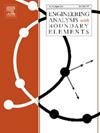Stokes flow past an array of circular cylinders through slip-patterned microchannel using boundary element method
IF 4.2
2区 工程技术
Q1 ENGINEERING, MULTIDISCIPLINARY
Engineering Analysis with Boundary Elements
Pub Date : 2024-09-20
DOI:10.1016/j.enganabound.2024.105925
引用次数: 0
Abstract
Two-dimensional viscous incompressible, pressure-driven, creeping flow at low Reynold's number (Re ≪ 1) around a series of circular cylinders in a slip-patterned rectangular microchannel is investigated numerically by using the boundary element method (BEM) based on a non-primitive variables approach. The non-primitive variables approach refers to the combination of stream function and vorticity variables. The Stokes equations are used to govern the flow of creeping fluid through a microchannel. We consider the alteration of the slip on both the upper and lower surfaces of the microchannel maintain the same phase (i.e., in-phase configuration). Here, the slip boundary condition refers to Navier's slip boundary condition. We considered both small as well as large patterned slip on both surfaces of the microchannel. Moreover, we have assumed that a number of cylinders of equal diameter are present in the in-line configuration in the path of flow. We studied streamlines, velocity profiles, pressure gradients, and the shear stresses with varied slip-length, and the radius of the cylinder, to get a complete comprehension of flow dynamics. We observed that the velocity and shear stress profiles exhibit significant variability in the case of fine slip patterning. Additionally, the proposed investigation holds several potential applications, such as drug capsule delivery systems, hemodynamics, bio-MEMS technology, and so forth.
利用边界元法计算通过滑移图案微通道的圆柱阵列的斯托克斯流
采用基于非原始变量方法的边界元法(BEM),对滑移矩形微通道中围绕一系列圆柱的二维粘性不可压缩、压力驱动、低雷诺数(Re ≪1)蠕动流动进行了数值研究。非原始变量法指的是流函数和涡度变量的组合。斯托克斯方程用于控制蠕动流体在微通道中的流动。我们考虑的是微通道上下表面的滑移变化保持同相(即同相配置)。这里的滑移边界条件是指纳维尔滑移边界条件。我们考虑了微通道两个表面上的小滑移和大滑移。此外,我们还假定在流动路径中存在多个直径相等的直列式圆柱体。我们研究了不同滑移长度和圆柱体半径下的流线、速度剖面、压力梯度和剪切应力,以全面了解流动动力学。我们观察到,在精细滑移图案的情况下,速度和剪切应力剖面表现出明显的变化。此外,这项研究还具有多种潜在应用前景,如药物胶囊输送系统、血液动力学、生物微机电系统技术等。
本文章由计算机程序翻译,如有差异,请以英文原文为准。
求助全文
约1分钟内获得全文
求助全文
来源期刊

Engineering Analysis with Boundary Elements
工程技术-工程:综合
CiteScore
5.50
自引率
18.20%
发文量
368
审稿时长
56 days
期刊介绍:
This journal is specifically dedicated to the dissemination of the latest developments of new engineering analysis techniques using boundary elements and other mesh reduction methods.
Boundary element (BEM) and mesh reduction methods (MRM) are very active areas of research with the techniques being applied to solve increasingly complex problems. The journal stresses the importance of these applications as well as their computational aspects, reliability and robustness.
The main criteria for publication will be the originality of the work being reported, its potential usefulness and applications of the methods to new fields.
In addition to regular issues, the journal publishes a series of special issues dealing with specific areas of current research.
The journal has, for many years, provided a channel of communication between academics and industrial researchers working in mesh reduction methods
Fields Covered:
• Boundary Element Methods (BEM)
• Mesh Reduction Methods (MRM)
• Meshless Methods
• Integral Equations
• Applications of BEM/MRM in Engineering
• Numerical Methods related to BEM/MRM
• Computational Techniques
• Combination of Different Methods
• Advanced Formulations.
 求助内容:
求助内容: 应助结果提醒方式:
应助结果提醒方式:


